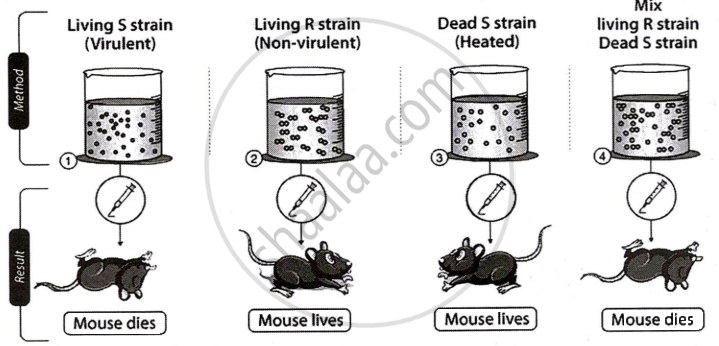Advertisements
Advertisements
प्रश्न
Griffith conducted a series of experiments on mice with two different strains of the bacterium Diplococcus pneumoniae.
- Describe the entire procedure for this experiment.
- Write the conclusion of this experiment.
- What would have been the result of the experiment if both strains of bacteria were first heat-killed, mixed and then injected in the mice?
उत्तर
- During the experiment, Griffith cultivated Diplococcus pneumonial bacteria, which exhibited two growth patterns. One culture plate contained smooth, glossy colonies (S), whereas the other contained rough colonies (R). The difference was attributable to the presence of a mucous coat in S strain bacteria, whereas R strain bacteria lacked one.
Griffith introduced both S and R strains into mice. The person infected with the S strain died from pneumonia, whereas the one infected with the R strain survived.
In the second stage, Griffith heat-killed the S strain bacteria and injected them into mice, but the mice survived. Then he combined the heat-killed S and live R strains. This concoction was put into mice, which died. In addition, he discovered live S-strain bacteria in deceased mice.
- Griffith inferred from his observations that S strain bacteria had altered R strain bacteria. The R strain inherited a 'transforming principle' from the heat-killed S strain bacteria, which made them virulent and he adopted this transforming principle as genetic material.
- If both strains of the bacteria were first heat-killed, mixed, and then injected into mice, the mice would stay alive because heat-killing bacteria would destroy their ability to cause infection.
APPEARS IN
संबंधित प्रश्न
Answer the following questions based on Hershey and Chases's experiments:
(a) Name the kind of virus they worked with and why?
(b) Why did they use two types of culture media to grow viruses in ? Explain.
(c) What was the need for using a blender and later a centrifuge during their experiments?
(d) State the conclusion drawn by them after the experiments.
Describe the Hershey and Chase experiment. Write the conclusion drawn by the scientists after their experiment.
Mention one significant difference between Phenotype and Genotype
Give one significant contribution of the given scientists
H. Boyer
Describe Avery, McLeod and McCarty’s experiment. State its significance.
Why did Hershey and Chase use radioactively labelled phosphorous and sulphur only? Would they have got the same result if they use radiolabelled carbon and nitrogen?
Which one is a hereditary disease?
The process of transformation is not affected by which of the following enzymes?
- DNase
- RNase
- Peptidase
- Lipase
Which one among the following was the first genetic material?
Transformation was discovered by ______
